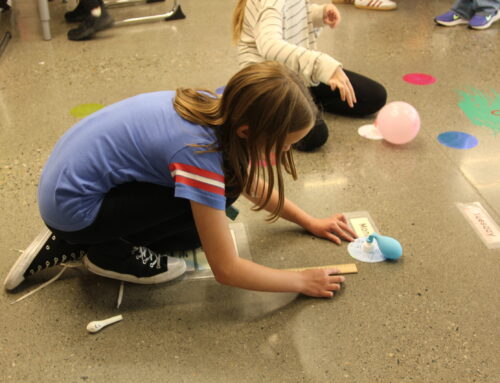
Students in the Gause Elementary Coding Club lean over giant paper maps created using markers to draw sets of lines and dashes of varying colors. Once the trail is complete they send their Ozobot robots to follow the commands they drew. This tiny robot reads colors through a sensor and responds with different movements. Students make the Ozobot advance, retreat, spin, light up, speed up and more.
“This is all a fun way for students to learn how to code, which is writing a computer program in a programming language,” said Sydney Termini, Gause first grade teacher and Code Club instructor. “We are working with the blocky code language using code.org. Students use a click and drop method to place their codes to become familiar with writing an algorithm to tell the computer what to do. We have also been working with color codes with these Ozobot robots. The kids have really enjoyed figuring out what these little bots can do.”
Termini began the club this fall and was surprised and the turnout of parents and students at an information night she held. “I had hoped to get 15 students for one session,” she said. “After that night it was clear we’d need two sessions. I started with more than 20 in each.” First through third grade students meet on Mondays and fourth and fifth graders meet on Thursdays. All sessions start after school and last for one hour.
Termini’s goal for the club is to provide students with the experience that computer science is fun and anyone can do it.
“I love listening to the group work with each other,” she said. “I love the sudden, ‘Yes! I finally got it.’ after they have worked hard on something. If someone is stuck they help each other problem solve, figuring out why their first, second or even third attempt hasn’t worked.
When helping others, the only rule is they must provide the help verbally and the person they are helping has to do the work. This is usually followed by an exclamation of, “Oh that’s why it wouldn’t work!”
“As I watch these groups, it’s fun to see the smiles and hear their laughter as they work through their courses on code.org,” Termini said.
According to Termini, providing exposure to computer science at the elementary level is important to lay the foundation for classes they could take in middle school. “My hope is that it will help them when they move to middle school by giving them confidence to try robotics and computer science when they get there and not think that it’s too hard for them,” she explained. “I hope that the problem solving that they have worked on independently or with a partner or group will help them persevere through problems they may find in math or science courses.
“So many jobs, now and in the future, require coding and knowledge in computer sciences,” she added. “I’m hoping it will help them prepare for different possibilities they may have not have thought of or would have known about without this background.”





